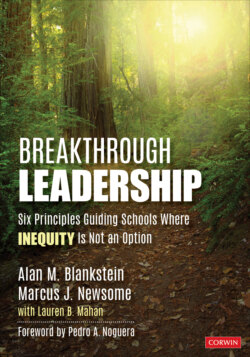Читать книгу Breakthrough Leadership - Alan M. Blankstein - Страница 13
На сайте Литреса книга снята с продажи.
Facing Facts About Racism, Food, and Housing Instability
ОглавлениеWhile facing the facts is often inconvenient as they don’t always tell the story we wish to hear, not doing so can be deadly as outlined in the “Lessons of Willful Blindness” section of this chapter. More recently, we are again grappling with the outcome of ignoring centuries of systemic racism that must be addressed forthrightly if we are to quell a civil meltdown and progress to a higher ground of equitable treatment and outcomes for children and families of color. This, too, will be discussed in subsequent chapters.
It is becoming increasingly clear that addressing the surface issues like food sustainability, as schools have, is plugging a roof whose gaping holes of inequity become only more apparent during national catastrophes like Columbine, Katrina, and corona. They beckon us to use our ingenuity, commitment, and moral outrage to not only solve the surface problem du jour, but also provide millions of desperate students a place in which they belong—one that provides safety, security, love, acceptance, and dignity as worthy human beings; a “home” that does not wash away when the rain begins to fall.
Yet our students are increasingly at risk, and home itself is ephemeral. The fastest-growing segment of the student population is no longer Hispanic; it’s homeless, with some 1.5 million students reporting homelessness in 2017–2018, an 11 percent increase over the prior year and the largest number ever reported. The biggest increase, of 103 percent, came in the number of children now living in unsheltered environments like cars, parks, and streets (Keystone State Education Coalition, 2020; National Center for Homeless Education, 2020). If these students all attended one district, they would far surpass the number of students in New York and Chicago—the largest and third-largest districts in the United States—combined.
Homelessness is clearly on the rise, but so is an array of issues facing children, including divorce, poverty, obesity, and depression, among others. While an argument can be made for the fragility of nearly all students nowadays, there is no denying their diversity of needs, all of which becomes apparent as each school day begins.
It is true that many students are still doing well, for example, and that others who might be expected to be “at risk” due to their demographic profile somehow beat the odds. Still others from backgrounds of low socioeconomic status receive the consistency and support from home and/or school that are necessary to thrive, as described in forthcoming chapters.
Yet educators are stretched to the limits in the demands placed on them by policymakers who don’t seem to understand the value of frontline professionals caring for and educating our nation’s children, or the depth of their diversity and needs. No wonder the United States was exploding in a series of teacher strikes leading up to the most recent crisis (Smith & Davey, 2019; Wolf, 2019).
This book will present examples of schools “beating the odds” before COVID-19, as well as a process for determining newly created approaches to educating children in a post-COVID-19 world. Perhaps more importantly, breakthrough leadership spotlights leaders at all levels now leveraging crises like this to shape local and national priorities toward a more equitable and healthy society for our children.
Courageous leaders at all levels have a unique opportunity in advancing an agenda of equitable and successful outcomes for students. The facts about what is at stake couldn’t be starker. Good leadership saves lives both in pandemics and in our profession.
The actions that Hilleman, his team, and ultimately the nation took saved millions of lives. The role educators play, likewise, for our nation’s children makes a difference in the trajectory of their lives: the difference between survival and malnourishment; between a future career and prison; and between young people who are socially, emotionally, and academically prepared for life and those who are on the road to a low-wage or impoverished existence (Valdez & Broin, 2015). Educators have the ability to affect students’ life trajectory through relationships, attitudes, social and emotional competence, contributions to learning conditions, and responses to student behavior (Coggshall et al., 2013). What will happen if we only respond to this and the civil rights crisis and return to “normal” afterwards?
